Best Places to Retire in the U.S.
Retirement Havens: The Top U.S. States to Retire
To help you determine your ideal retirement destination, we've listed the leading retirement states alphabetically with their top five cities that are most popular with retirees. Keep in mind, only you can decide what city is best for your unique needs, so its wise to define your priorities and budget when considering your ideal retirement destination. While cost of living and access to good medical care are important, also consider the quality of life offered, climate, crime rate and risk of natural diasters. This list will help you weigh the pros and cons of these top retirement destinations and narrow down your list so you can do further research on the ones that appeal the most to you. | |
 Paul Bradbury/Caia Image / Adobe Stock
|
Arizona:
- Tucson: Sunny weather year-round, mountain views, Saguaro National Park, vibrant arts scene, affordable living. Median Home Cost: $380,000.
- Phoenix: Desert scenery, Piestewa Peak hiking, vibrant downtown, diverse neighborhoods, growing job market. Median Home Cost: $525,000.
- Scottsdale: Upscale resort town, world-class golf courses, luxury amenities, scenic McDowell Mountains. Median Home Cost: $780,000.
- Flagstaff: Cool mountain town, access to Grand Canyon, Northern Arizona University campus, diverse outdoor activities. Median Home Cost: $500,000.
- Green Valley: Active retirement community, affordable housing, golf courses, access to healthcare, desert beauty. Median Home Cost: $325,000.
Pros: Warm weather, outdoor activities, scenic landscapes, active communities, variety of living options.
Cons:
Very hot summers, Phoenix and Tucson have brutal June-August heat, often exceeding 110°F. High A/C bills, dust storms, and wildfires. Limited water means cautious usage and restrictions on landscaping.
| |
 Phoenix skyine Photo by F11photo / Adobe Stock
|
Colorado:
- Denver: Vibrant city with mountain access, cultural attractions, craft breweries, active lifestyle. Median Home Cost: $829,000.
- Fort Collins: College town atmosphere, outdoor activities, breweries, stunning scenery. Median Home Cost: $600,000.
- Colorado Springs: Pikes Peak views, affordable housing, vibrant downtown, access to nature. Median Home Cost: $488,515.
- Boulder: University town with intellectual vibe, mountain biking trails, farmers' markets. Median Home Cost: $851,740.
- Durango: Historic charm, scenic train rides, access to San Juan Mountains, laid-back lifestyle. Median Home Cost: $750,000.
Pros: No state income tax for retirees, breathtaking scenery and endless outdoor activities, pleasant climate with four distinct seasons, Vibrant cultural scene in cities like Denver and Boulder, clean air and sunshine.
Cons: High cost of living, especially housing, wildfire risk in dry summers which impacts air quaity, limited public transportation outside major cities, altitude sickness for some newcomers, snow and winter driving can be a challenge.
| |
 Denver skyline Photo by Teri / Adobe Stock
|
Florida:
- St. Petersburg: Artsy vibe, world-class museums, stunning waterfront, thriving cultural scene. Median Home Cost: $350,000.
- Daytona Beach: Sunshine, affordability, car racing scene, laid-back coastal atmosphere. Median Home Cost: $230,000.
- Sarasota: Cultural gems like Ringling Museum, beautiful beaches, thriving arts scene. Median Home Cost: $475,000.
- Naples: Upscale coastal living, pristine beaches, golf courses, luxurious amenities. Median Home Cost: $1,000,000.
- Melbourne: Affordable coastal haven, diverse cultural offerings, vibrant downtown. Median Home Cost: $380,000.
Pros: No income tax, year-round sunshine, endless beaches, and access to vibrant coastal cities with cultural offerings and relaxed lifestyles.
Cons: Hurricanes and flooding: Coastal areas vulnerable to storms and rising sea levels. high insurance costs, heat/humidity, high electric bills due to A/C, alligators.
| |
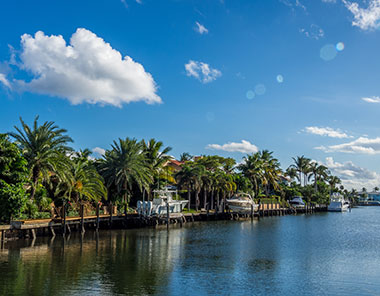 Photo by Oldmn / Adobe Stock
|
Georgia:
- Savannah: Historic architecture, cobblestone streets, oak trees draped in Spanish moss, coastal beauty. Median Home Cost: $425,000.
- Atlanta: Bustling metropolis with museums, sports teams, diverse neighborhoods, vibrant nightlife. Median Home Cost: $410,000
- Athens: Home to the University of Georgia, eclectic college town atmosphere, music scene, diverse restaurants. Median Home Cost: $325,000
- Blue Ridge: Mountain town with scenic views, hiking trails, waterfalls, wineries, arts and crafts scene. Median Home Cost: $355,000
Pros: Warm weather, Southern hospitality, diverse cities, historic towns, and access to mountains and beaches.
Cons: Tornados, usually in the southwestern part of the state, near the Alabama border. The areas around Albany, Macon, Columbus, and Tifton are statistically more prone. Such tornados are usually weak (EF0 - EF1, but EF2s can occur causing more damage).
| |
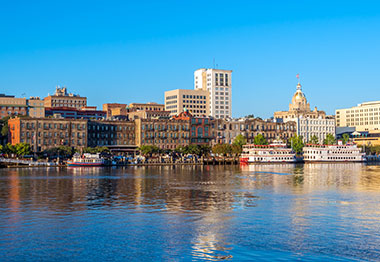 Savannah waterfront Photo by F11photo / Adobe Stock
|
New Mexico:
- Santa Fe: Artsy capital city with adobe architecture, Native American art, vibrant cultural scene, scenic surroundings. Median Home Cost: $660,000
- Albuquerque: Balloon Fiesta, Sandia Mountains, Old Town Plaza, diverse cultural heritage, outdoor activities.Median Home Cost: $395,000
- Taos: Artistic community, mountain views, historic Taos Pueblo, hiking trails, art galleries. Median Home Cost: $649,000
- Las Cruces: Gateway to White Sands National Park, Organ Mountains views, New Mexico State University campus, affordable living. Median Home Cost: $346,000
- Silver City: Historic mining town, artsy vibe, scenic Gila National Forest, outdoor adventures.
Top reasons: Unique culture, stunning landscapes, mild climate, diverse arts scene, and affordable cost of living. Median Home Cost: $242,000
Pros: Affordability and Sunshine: lower cost of living compared to many other retirement destinations. Soak up over 300 days of sunshine a year in a dry climate ideal for certain health conditions.
Diverse Landscapes and Culture: Explore breathtaking deserts, mountains, forests, and canyons. Immerse yourself in a vibrant blend of Native American, Hispanic, and Anglo influences through traditional dances, fiestas, museums, and art galleries.
Relaxed Pace and Outdoor Activities: Enjoy a laid-back atmosphere and friendly vibe. Hike, ski, and bask in the beauty of New Mexico's natural wonders, from Carlsbad Caverns National Park to the Sangre de Cristo Mountains.
Cons: Limited Healthcare and Isolation: Access to specialists and advanced care can be limited in rural areas. Be prepared for potential isolation depending on your chosen location, with amenities like grocery stores and entertainment further apart. Extreme Weather and Crime: Prepare for hot summers, cold winters, and high-altitude dryness. Certain cities within the state have higher crime rates than the national average, so research carefully if safety is a top priority.
| |
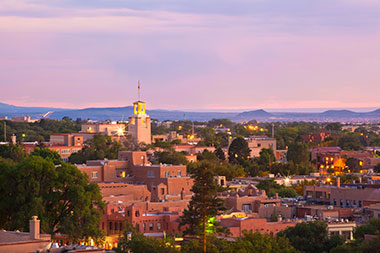 Santa Fe skyline Photo by M. Makela / Adobe Stock
|
North Carolina:
- Asheville: Blue Ridge Mountains majesty, hiking trails, craft breweries, arts scene. Median Home Cost: $430,000.
- Wilmington: Quaint coastal town, historic charm, beautiful beaches, relaxed atmosphere. Median Home Cost: $340,000.
- Raleigh: Growing city with museums, parks, diverse restaurants, lively downtown. (Median Home Cost: $420,000)
- Hendersonville: Mountain views, historic Main Street, vibrant arts scene, charming shops. Median Home Cost: $320,000.
- Charlotte: Big-city amenities, museums, sports teams, diverse neighborhoods, job opportunities. Median Home Cost: $390,000.
Pros: Beautiful scenery: Mountains, beaches, and rolling hills offer diverse landscapes and outdoor activities. Mild climate with four distinct seasons, generally warm winters and pleasant summers. Lower cost of living compared to many other retiree destinations. No state income tax and property tax exemptions for seniors.
Cons: Limited public transportation, personal vehicles might be necessary outside major cities. Hurricanes and flooding, coastal areas vulnerable to storms and rising sea levels. Mixed healthcare access, top-tier facilities in some areas, but rural areas may have limited specialists.
| |
 Chartlotte skyline
Photo by 1778011 / Pixabay
|
Pennsylvania:
- Harrisburg: Affordable, excellent healthcare, vibrant downtown, walkable streets. Median Home Cost: $260,000.
- Reading: Reading offers a charming downtown, thriving arts scene, and lower cost of living compared to other popular retirement destinations. Median Home Cost: $225,000.
- Lancaster: Amish culture, rolling farmland, farmers' markets, peace and tranquility. Median Home Cost: $400,000.
- Scranton: Revitalized downtown, Pocono Mountains access, affordable housing. Median Home Cost: $180,000.
- Allentown: A bustling city with a revitalized downtown, Allentown features museums, parks, and easy access to major highways for exploring the region. Median Home Cost: $285,000
Pros: Diverse landscapes: Mountains, forests, rolling hills, and coastline offer scenic beauty and varied outdoor activities. Lower cost of housing and overall expenses compared to many coastal states. Rich history and culture: Charming towns, museums, arts festivals, and vibrant cities like Philadelphia provide cultural experiences.
No state income tax on retirement income and generous property tax exemptions for seniors.
Cons: Long, cold snowy winters, high property taxes: While exemptions exist, overall property taxes in some areas can be higher than national averages. Limited public transportation, personal vehicles might be necessary in many areas, especially outside major cities.
| |
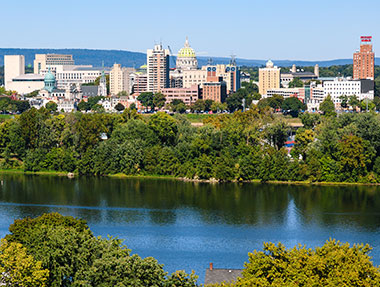 Harrusburg, Pensylvavnia
Photo by Zack Frank / Adobe Stock
|
South Carolina:
- Charleston: Historic architecture, cobblestone streets, beautiful harbor, charming neighborhoods. Median Home Cost: $580,000.
- Myrtle Beach: Affordable coastal haven, pristine beaches, golf courses, family-friendly activities. Median Home Cost: $260,000. .
- Greenville: Up-and-coming city with vibrant downtown, art scene, diverse restaurants, breweries. Median Home Cost: $390,000.
Pros:
Warm climate: Long summers and mild winters offer year-round outdoor enjoyment. Picturesque beaches, islands, and ocean activities. Lower cost of living compared to many other coastal states. Southern hospitality, Welcoming communities and friendly charm create a relaxed atmosphere. No state income tax on retirement income and some property tax exemptions for seniors.
Cons: Hurricanes and flooding: Coastal areas vulnerable to storms and rising sea levels. Limited public transportation, personal vehicles might be necessary in many areas. Rural healthcare access: Top-tier facilities in major cities, but rural areas may have limited specialists. Summer heat and humidity: Hot, humid summers can be uncomfortable for some retirees. Higher crime rates: Crime rates in some areas, especially larger cities, are higher than the national average.
| |
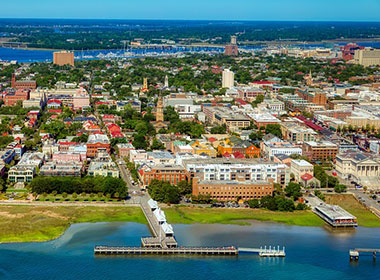 Charleston, South Carolina Photo by Photo by 177801 / Pixabay
|
Tennessee
- Nashville: Country music capital, vibrant downtown, eclectic neighborhoods, diverse entertainment options Median Home Cost: $540,000.
- Knoxville: Scenic Great Smoky Mountains nearby, University of Tennessee campus, affordable living, outdoor activities. Median Home Cost: $315,000.
- Chattanooga: Revitalized waterfront, Lookout Mountain views, art scene, hiking trails, affordable housing. Median Home Cost: $340,000.
- Franklin: Charming historic town, Williamson County charm, excellent schools, arts and crafts scene. Median Home Cost: $725,000.
- Gatlinburg: Great Smoky Mountains National Park, Mountain scenery, hiking trails, stunning waterfalls, wildlife encounters, family-friendly attractions. Median Home Cost: $525,000.
Pros: Beautiful scenery: mountains, lakes, forests, and rolling hills offer stunning landscapes and outdoor activities. Vibrant downtowns. Afordable living: low cost of housing, groceries, and other expenses compared to national averages. Good access to healthcare. No state income tax on retirement income and property tax exemptions for seniors. Warm climate: Generally mild winters and long summers, with plenty of sunshine. Friendly communities: Southern hospitality and relaxed atmosphere offer a welcoming environment.
Cons:
Risk of tornados. Limited public transportation: Relying on personal vehicles might be necessary in many areas.
Higher crime rates: Crime rates in some areas, especially larger cities, are higher than the national average.
Rural healthcare access: Top-tier facilities in major cities, but rural areas may have limited specialists.
Education system: Public school rankings in some areas fall below national averages.
| |
 Chatanooga, Tennessee
Photo by Christopher Boswell / Adobe Stock
|
Texas:
- Austin: Live music capital, quirky and vibrant city, tech hub, diverse food scene, outdoor activities. Median Home Cost: $525,000.
- San Antonio: Rich history, Alamo and River Walk, Tex-Mex cuisine, affordable housing, top healthcare institutions. Median Home Cost: $525,000.
- Fredericksburg: Hill Country charm, wineries, charming Main Street, German heritage, scenic landscapes. Median Home Cost: $525,000.
- Denton: College town atmosphere, University of North Texas campus, vibrant arts scene, diverse restaurants. Median Home Cost: $525,000.
- Corpus Christi: Coastal haven, pristine beaches, aquatic activities, Padre Island National Seashore, affordable living. Median Home Cost: $525,000.
Pros: Diverse cities, warm weather, Tex-Mex food, access to nature and activities. Affordability: Generally lower cost of living compared to the national average, particularly in housing and taxes.
No state income tax: Retirees on fixed incomes can keep more of their money.
Diverse landscapes: Mountains, deserts, beaches, and vast plains offer varied scenery and outdoor activities.
Sun-soaked climate: Warm winters and long summers provide ample sunshine for outdoor enthusiasts.
Culture and entertainment: Vibrant cities like Austin and Dallas offer museums, nightlife, and diverse dining options.
Cons:
Extreme weather: Scorching summers can be uncomfortable, and hurricanes and tornadoes pose potential threats.
Limited public transportation: Reliance on personal vehicles may be necessary in most areas.
Rural healthcare access: Top-tier facilities in major cities, but rural areas may have limited specialists.
Property taxes: While overall cost of living is lower, property taxes can be higher than in some other states.
Education system: Public school rankings in some areas fall below national averages.
| |
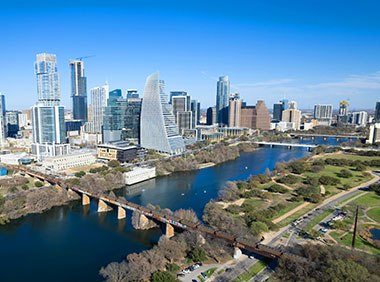 Austin, Texas and Colorado river Photo by Photo by 177801 / Pixabay
|
Virginia:
Top reasons: Historic appeal, diverse cities, scenic beauty, access to nature, and a generally temperate climate.
- Richmond: Historic capital city with museums, art scene, diverse neighborhoods, James River access. Median Home Cost:$370,000.
- Charlottesville: Home to the University of Virginia, vibrant college town atmosphere, scenic Blue Ridge Mountains nearby. Median Home Cost: $450,000
- Norfolk: Coastal city with maritime heritage, naval base, waterfront attractions, diverse cultural offerings. Median Home Cost: $280,000
- Williamsburg: Colonial charm, living history museums, restored 18th-century buildings, theme parks. Median Home Cost: $420,000
- Roanoke: Mountain views, hiking trails, vibrant downtown, art scene, access to the Blue Ridge Parkway. Median Home Cost: $300,000.
Pros:
Four distinct seasons: Enjoyable spring and fall, mild winters, and pleasant summers offer varied outdoor activities.
Scenic beauty: Mountains, beaches, rolling hills, and historic sites provide diverse landscapes and sightseeing opportunities.
Affordable living: Lower cost of housing compared to many coastal states, with some variations depending on location.
Tax benefits: No state income tax on retirement income and property tax exemptions for seniors.
Historic charm: Rich history and colonial towns like Williamsburg offer unique cultural experiences.
Cons:
Hurricanes and flooding: Coastal areas vulnerable to storms and rising sea levels.
Limited public transportation: Relying on personal vehicles might be necessary in many areas.
Rural healthcare access: Top-tier facilities in major cities, but rural areas may have limited specialists.
Traffic congestion: Major cities and surrounding areas can experience heavy traffic, especially during peak hours.
Education system: Public school rankings in some areas fall below national averages.
| |
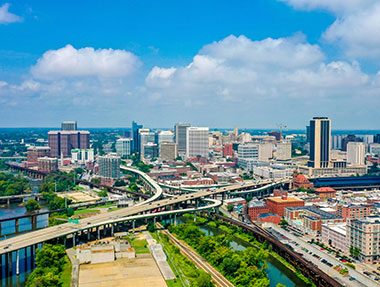 Richmond, Virgina Richmond, Virgina
Photo by Raynor / Adobe Stock |
Washington:
Top reasons: Beautiful scenery, access to outdoors, diverse cities, cultural offerings, waterfront towns.
- Seattle: For those with high housing budgets, Seattle offers great of life. Seattle offers a wonderful variety of cultural activities, waterfront beauty, Pike Place Market, vibrant tech hub, stunning scenery. It does however, have high traffic at rush hour. Median Home Cost: $1,030,000
- Sequim: A gem of a retirement town, Sequim is known for its mild climate, beautiful scenery, and friendly community. It borders the Strait of Juan de Fuca, which connects the Pacific Ocean to Puget Sound. It is sometimes referred to as a "banana belt" due to the rain shadow effect of the Olympic Mountains creating a notably drier and sunnier climate than surrounding regions. Being a small town, shopping and dining options are limited but there are larger towns nearby. Median Home Cost: $590,000.
- Olympia: State capital charm, Capitol Lake views, Deschutes Estuary boardwalk, close proximity to nature. Median Home Cost: $460,000.
- Walla Walla: Wine country haven, award-winning wineries, charming downtown, diverse restaurants, scenic landscapes. Median Home Cost: $430,000.
- Bellingham: Historic waterfront town, Whatcom Falls Park, close proximity to Canadian border, arts and culture scene. Median Home Cost: $650,000.
- Port Townsend: Charming Victorian-era architecture, vibrant arts scene, stunning coastline, ferry access to Whidbey Island. Median Home Cost: $700,000.
Pros:
Stunning scenery: Mountains, oceans, forests, lake and rivers, lush landscapes offer abundant beauty and outdoor activities.
Mild climate: Rainy winters and cool summers provide a welcome escape from extreme temperatures.
No state income tax: Retirees on fixed incomes can keep more of their money.
Thriving cities: Seattle and other urban centers offer vibrant cultural experiences, museums, and entertainment options.
Dog-friendly environment: A welcoming atmosphere for pets makes it a great choice for animal lovers.
Cons:
High cost of living: Housing, groceries, and other expenses can be significantly higher than the national average.
Frequent rain. Rainy winters can be gloomy and lead to Seasonal Affective Disorder (SAD) for some.
Traffic congestion: Seattle and surrounding areas experience significant traffic jams, impacting commutes and daily activities.
Earthquake risk: The state sits on a major fault line and faces the threat of earthquakes, though not an everyday occurrence.
Wildfire risk: Dry summers and forests increase the risk of wildfires, impacting air quality and outdoor activities.
|
Oregon:
Top reasons: Beautiful scenery, access to outdoors, diverse cities, cultural offerings, waterfront towns from charming coastal towns to vibrant cities and everything in between. Here are some top choices:
- Brookings: Nestled on the breathtaking Oregon coast, Brookings beckons with its oceanfront beauty, mild climate, and outdoor activities like hiking, fishing, and exploring nearby Redwoods National Park. The median home price sits around $470,000, making it a potentially affordable coastal option.
- Bend: Located in Central Oregon, Bend is a haven for outdoor enthusiasts. Hiking, biking, skiing, and fishing are just a few activities this vibrant city offers. It boasts a strong cultural scene with museums, art galleries, and breweries. The median home price is higher at $720,000.
- Eugene: This college town located in the Willamette Valley offers a laid-back lifestyle, beautiful natural surroundings, and a vibrant cultural scene. Enjoy the nearby Cascades Mountains and explore the city's museums, theaters, and restaurants. The median home price is around $450,000.
- Salem: As the state capital, Salem offers a diverse cultural scene with museums, art galleries, and the Oregon State Fair. Situated in the Willamette Valley, it offers a balance of city amenities and natural beauty. The median home price is around $420,000.
Pros:
Beautiful scenery and outdoor activities: From mountains to coasts, Oregon offers stunning landscapes and plenty of options for staying active.
Mild climate: Escape extreme temperatures with Oregon's generally mild year-round weather.
No state income tax: Keep more of your money with this benefit for retirees.
Thriving cities and diverse communities: Enjoy vibrant urban centers or close-knit communities, depending on your preference.
Dog-friendly environment: Many Oregon communities welcome pets.
Cons:
High cost of living: Housing and healthcare can be expensive compared to the national average.
Frequent rain: Enjoy the greenery, but be prepared for potentially gloomy winters and potential seasonal challenges.
Traffic congestion: Major cities experience rush hour traffic jams.
Natural disaster risks: Earthquakes, flooding and wildfires are potential concerns in some areas.
Remember, your ideal location depends on your priorities and budget. Consider factors like healthcare access, climate, access to shopping and amenities, and cost of living when making your decision.
|
|
 Seattle, Washington
Photo by Luca Micheli / Unsplash |
|
|
 Paul Bradbury/Caia Image / Adobe Stock
Paul Bradbury/Caia Image / Adobe Stock
 Phoenix skyine
Phoenix skyine Denver skyline
Denver skyline Photo by Oldmn / Adobe Stock
Photo by Oldmn / Adobe Stock
 Savannah waterfront
Savannah waterfront Santa Fe skyline
Santa Fe skyline Chartlotte skyline
Chartlotte skyline Harrusburg, Pensylvavnia
Harrusburg, Pensylvavnia Charleston, South Carolina
Charleston, South Carolina Chatanooga, Tennessee
Chatanooga, Tennessee Austin, Texas and Colorado river
Austin, Texas and Colorado river Richmond, Virgina
Richmond, Virgina Seattle, Washington
Seattle, Washington